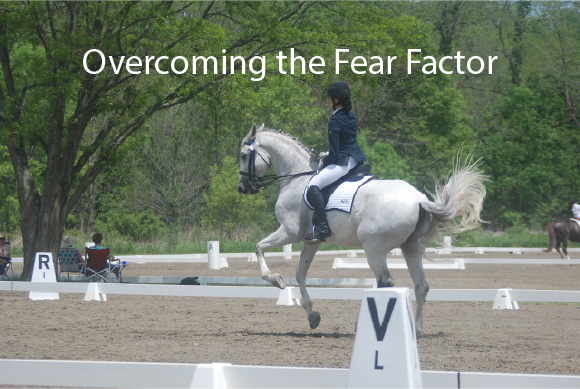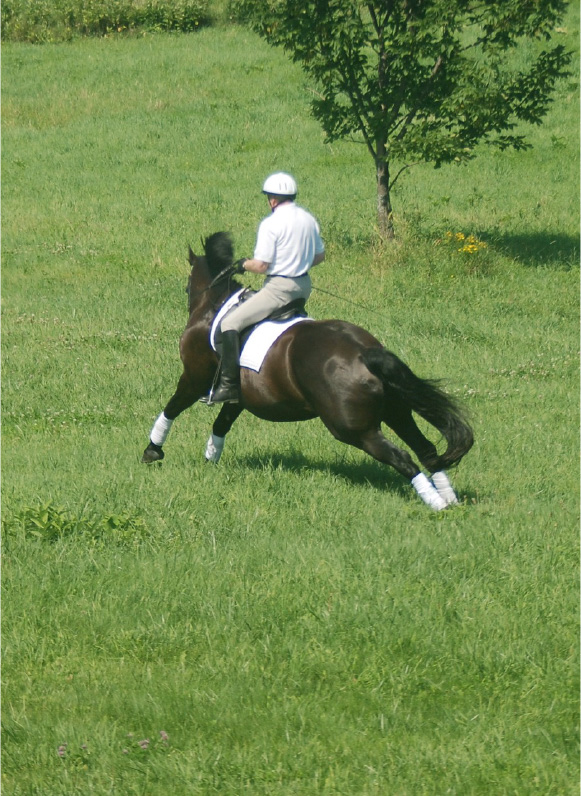Overcoming the Fear Factor
By Nikki Alvin-Smith

Horses are big, unpredictable animals and accidents happen. You may have suffered a bad introduction to horses as a child, being ‘thrown’ out of your depth at a ranch adventure that went awry or perhaps you are an experienced rider that has taken a bad fall and is hesitant to get back on your horse. Which is unfortunate when he is the one and only equine love of your life and he eats you out of house and home between antics.
Fear is a necessary survival skill so the first thing is to accept that it is O.K. to be scared. There are several methods to overcome this fear factor and here is some general advice to give you direction.
Identify What Scares You
You don’t have to experience a complete horse wreck to be scared to get back on the horse. It could have been a narrow escape that you survived with no physical injury. You could truly have been in danger or you may have perceived you were so your body and instincts took over creating tension and precipitating a near miss.
So take an honest look at your own backstory and that of your horse. Was it a one off event or a series of similar events? Was it just a general feeling you have around a particular horse or in a particular environment? Determine whether it was truly a random accident.
What could have been done to prevent it? Could you or your horse have been better prepared in your fitness or training? This will be an important starting point in resolving the issue and bringing you back to a state of relaxation and happiness in the saddle.
Make a Plan
Your ‘recovery plan’ should include one for you and one for your horse. If the behavior of your horse was completely errant the first thing to consider is was his resistance born of illness or injury, soreness or lameness. In my lifetime as a horsewoman I have known very few horses that go out of their way to hurt a rider. You can come across a horse that has been mistreated, receives a trigger that sets him off mentally but these horses are fairly easy to identify. These horses should be left to a professional.
There are many modalities available today including thermal apps you can download to a tablet to check for inflammation or health issues, microcurrent therapy is pretty amazing and of course common vet/chiro examinations.
When in doubt, consult a medical expert.
Also check to make sure all your tack fits properly. Bits that are too small or harsh, throat latches that are too tight, nosebands that are too tight, saddles that pinch can cause all sorts of pain and training issues.
When you are confident that your horse is sound and your tack is well-fitted, then the next step is to look at his lifestyle. If your horse is misbehaving or being over excitable be certain that he is not being overfed with a high grain ration or a ration that is too high in protein. Certain horses have a strong reaction to corn and oats so check that your grain ration is appropriate for your age and breed of horse and the type and amount of work he is doing. Also give him as much time out in the field as possible. Horses that are turned out for longer periods will tend to be happier, healthier and quieter to ride.
The key to success with your horse is good education built on a solid foundation of trust. Time you spend teaching your horse good manners and bonding with him on the ground will help you in the saddle. So plan a program of exercises you can do together on the ground where you know you will be confident. These can be anything from carrot stretches (which you know he’ll like), to round penning, obstacle training, work on the longe line, breathing and natural horsemanship exercises. There are many trainers you can consult via DVD or by reading their books such as Linda Tellington Jones, Mark Russell, Jenny Rolfe, Buck Brannaman, John Lyons, Lisa Wysocky etc. These valuable resources are inexpensive and at your fingertips so choose whatever fits your needs and style of riding and get busy.
Remember any time you are with your horse you are teaching him something and pecking order and respect is being determined. Even if you are just going in his stall to throw in hay, make sure he backs up out of your space respectfully. You should make your horse acquiesce to some request you make every time you see him.

Setup for Success
When you are ready to hit the saddle again set yourself up for success with a set of simple goals. Do not overface you or your horse by asking too much too soon. For example, if the issue was with him balking at fences, then don’t start by asking him to repeat jump a fence he previously refused. You must look to his training and start him back to basics by walking and then trotting over poles on the ground, then jump a few cross poles and then on to a small fences and courses. Begin your program in an enclosed space either inside or outside where you will have maximum control of your horse. If possible try not to ride alone, but have a knowledgeable equestrian friend stand center of the ring to give you encouragement and help if necessary.
If he is prone to excitement use the longe line and exercise him through all three gaits preferably with side reins to teach him to accept the bit. If he does not stand quietly to mount then this is something you need to teach him and it may require some patience.
Most issues that occur in the saddle are a result of lack of education either on the part of the horse and/or the rider. Green horses and green riders are a recipe for disaster so if you both lack experience have someone more accomplished and experienced train your horse while you ride one that can safely teach you. Neither horse nor rider can learn without relaxation and a tense rider may create a tense horse and vice versa. It is always best to work with a professional, even if it is just once a week to progress your riding skills and education.
How to Control Tension
In Horse Bits magazine last month I covered the methods of NLP and positive thinking and how to flip things around mentally for success, so I will not repeat them here.
You are probably asking yourself how can I control tension? Your posture and breathing greatly affect tension. Your involuntary nervous system is located in the ganglia by the rib heads in the thoracic spine. This finely tuned system is responsible for how your muscles work and how your body deals with anxiety. For example, if you ride with your shoulders hunched up you will be limiting the smoothness with which your lungs can operate which may in turn make you breathless and cause your heart to beat faster. As your involuntary nervous system is now working harder it will send a message to your adrenal glands and here you go on the anxiety train.
Work on correcting your posture with an open chest, arms relaxed and hanging off the shoulders by taking your shoulders up and rounding them backwards and letting gravity take the weight of your arms down. Then bend your arms at the elbow and keep your elbows just touching your waist. This will allow you to center your core and use your core to help in your riding. Make sure you have the key riding structure of axis through the ear/elbow/hip/heel line and from the bit through the rein with thumbs on top, wrist flat to the outside and to the elbow.
Breathing can be controlled and this will also help both you and your horse by lessening tension. At the walk try breathing in for four hoof falls and then breathing out for four hoof falls. As you are counting this is also a distraction and distractions can also be beneficial as a technique to overcome fear. Distraction is a valuable teaching tool and can aid in learning and relaxation.
As a clinician even when I am training advanced riders I employ the method of distraction when they are having difficulty learning a new movement. For example a rider may have difficulty with the changes every three. I will ask them to count the changes out loud. 1,2,3, then 2,2,3, then 3,2,3 etc. The rider is now focused on the timing, is breathing in each stride and their aids for the change will be properly timed as a result because their mind has already determined when the change is coming. This also helps them keep in rhythm, which is another key in keeping relaxation for both horse and rider.
It is also important to be mindful that no rider is perfect. Every time you do anything things are going to go wrong. Allow yourself the mistakes but do not become overly focused on them. The paralysis of analysis can set in and you must use action and not just words, even if they are positive ones.
Very often people become so concerned with their progress and journey to improvement that they totally forget to celebrate the small successes that they achieve. It is important not to become disheartened but to focus on the positives.
For example, maybe your horse was agoraphobic and you were only able to ride him indoors when he first came home. You spent time walking him short distances outside and gradually increased them until his breathing became relaxed and he started to enjoy the experience. Today he took off fast in the canter but that doesn’t mean you have failed. Figure out what caused the behavior. Did he lose his balance and rush, did you lose your balance? If this is the case then work on his lateral balance in the trot and work on his balance in canter on the longe line. Did something spook him in which case his response was justifiable. Or was he just not listening and excited? If this is the cause you need to put in more instructions to have him truly on your leg and aids and listening to your requests. Don’t punish him or yourself, just work on transitions and make them more frequently.
Avoid Negative People
This is not always possible especially if you have a member of your family that is always negative. We do get to choose our friends and role models so make wise choices. Positive input and encouragement is extremely important to our success in life. No man is after all, an island.
Remember, the only limits you have are those you set upon yourself. Do not let other people define them for you and try to avoid setting limits on yourself.
If you become overwhelmed or feel a situation is too dangerous then do not hesitate to consult a professional trainer. Ensure that you choose someone that has a positive attitude and energy in their method of training horses and teaching riders. Many of us have lost confidence at some point or other and overcome it and are empathetic with your situation and have much experience in aiding others with similar issues. Your quest to get back to riding with happiness and confidence is always attainable!
About the author: Nikki Alvin-Smith is an international Grand Prix dressage trainer/clinician who has competed in Europe at the Grand Prix level earning scores of over 72%. Together with her husband Paul, who is also a Grand Prix rider, they operate a private horse breeding/training farm in Stamford, NY.


